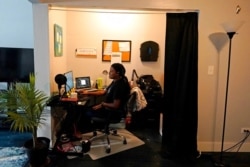Prior to the pandemic, about 5 million Americans worked remotely. But COVID-19 forced U.S. employers to allow telework on a massive scale, resulting in an estimated 75 million people working from home over the past year.
Some experts say there’s no going back now that both employers and workers have learned that telework can be effective.
“The pandemic has radically changed how we view telework or remote work,” says Timothy Golden, a professor of management at Rensselaer Polytechnic Institute. “It's changed mindsets. It's changed cultural and social norms for where and how work gets done. … Many individuals and companies have realized that we can work remotely effectively. And so, I think remote work is here to stay.”
Companies are now trying to figure out how a post-pandemic workforce will operate. That could entail a hybrid model where some people are in the office most of the time, some primarily telework and others do a mix of the two.
“We are going to err on the side of letting more people work remotely for longer periods of time,” says Ravi Gajendran, chair of the Department of Global Leadership and Management in the College of Business at Florida International University.
“Then, they're going to find that that's not working as well, and the pendulum will sort of swing slightly back towards the office. It's not going to come back to what it was previously, but what we're going to find is, as new employees join, as new teams form, and as people who have not worked together before are now working remotely, things are not going to be as smooth.”
Golden already has seen indications that companies are adapting to increased remote work by considering bringing in a chief remote work officer, an executive-level position on a par with a chief technology officer or chief diversity officer.
“If you look at the discussion of remote work and C-suite [executive-level managers], it probably was nonexistent prior to the pandemic. Now, I think it’s on every CEO’s mind,” Gajendran says.
“Previously, we would never have wanted to run this experiment where they had a significant portion of their employees working remotely, because the risk would have been just too high to try it. But now that we've been forced to try it, they've discovered that a much larger proportion of employees can work remotely without there being significant losses to the organization.”
Previous studies show that productivity remains stable, or actually increases, once employees start working from home.
“We know that many employees have been highly productive during the pandemic and have been able to carry on their work in a fashion that was consistent with their productivity before the pandemic,” Golden says.
That’s a reason major companies like Facebook, Twitter, Ford Motor Company and Citigroup already have said they plan to allow more telework going forward. Employers that don’t increase telework opportunities could face the possibility of losing talent.
“You've seen many large companies, and in different industries, make announcements about the future of their workforce in how it is likely to be hybrid. And some workers will be working remotely on a permanent basis, and others will be in a hybrid form,” Golden says. “Companies that do this right and do this in the right way, will have a competitive advantage over those who do not.”
Increased telework could free employees from having to live close to where they work. That could also benefit employers who won’t have to be limited to the local talent pool. More jobs could go to places with lower costs of living and ultimately, overseas.
“It could go to Asia or Africa or South America,” says Gajendran. “So, once companies figure out roles that can be done remotely, their instinct would be to use that as a way to reduce their costs. And so, that could create more instability in the labor markets.”
Allowing more telework is likely to have implications on the commercial real estate market, as well.
“Companies are looking to reenvision the office, and asking themselves, ‘What is the purpose of the office? And why do we pull workers together every day?’” Golden says. “Thinking about the purpose of the office, that has implications for their office footprint in terms of office space.”


